Magnetic Holography and Its Application to Data Storage
Abstract
1. Introduction
2. Principles of Recording and Reconstruction of Magnetic Holography
2.1. Recording of Magnetic Hologram
2.2. Reconstruction from Magnetic Hologram
3. Magnetic Holographic Memory
3.1. Reconstructed Image and Error Ratio of Magnetic Holography
3.2. Multiplexity
3.3. Recording Media
3.3.1. Properties of Single Layer and Magnetic Microcavity Media
3.3.2. Concept and Properties of Heat Dissipation Multilayer Media
4. Conclusions
Funding
Institutional Review Board Statement
Informed Consent Statement
Data Availability Statement
Acknowledgments
Conflicts of Interest
References
- Mikaeliane, A.L.; Bobrinev, V.I. Holographic memory devices. Opto Electron. 1970, 2, 193–199. [Google Scholar] [CrossRef]
- Rajchman, J.A. An Optical Read-Write Mass Memory. Appl. Opt. 1970, 9, 2269–2271. [Google Scholar] [CrossRef] [PubMed]
- Sakaguchi, M.; Nishida, N.; Nemoto, T. A New Associative Memory System Utilizing Holography. IEEE Trans. Comput. 1970, C-19, 1174–1181. [Google Scholar] [CrossRef]
- Takeda, Y. Hologram memory with high quality and high information storage density. Jpn. J. Appl. Phys. 1972, 11, 656–665. [Google Scholar] [CrossRef]
- D’auria, L.; Huignard, J.; Spitz, E. Holographic read-write memory and capacity enhancement by 3-Dstorage. IEEE Trans. Magn. 1973, 9, 83–94. [Google Scholar] [CrossRef]
- Nomura, H.; Okoshi, T. Storage density limitation of a volume-type hologram memory: Theory. Appl. Opt. 1976, 15, 550–555. [Google Scholar] [CrossRef] [PubMed]
- Hong, J.H.; McMichael, I.; Chang, T.V.; Christian, Q.; Paek, E.G. Volume holographic memory systems: Techniques and architectures. Opt. Eng. 1995, 34, 2193–2203. [Google Scholar] [CrossRef]
- Rakuljic, G.A.; Leyva, V.; Yariv, A. Optical data storage using orthogonal wavelength multiplexed volume holograms. Opt. Lett. 1992, 17, 1471–1473. [Google Scholar]
- Li, H.-Y.S.; Psaltis, D. Three-dimensional holographic disks. Appl. Opt. 1994, 33, 3764–3774. [Google Scholar] [CrossRef]
- Pu, A.; Psaltis, D. High-density recording in photopolymer-based holographic three-dimensional disks. Appl. Opt. 1996, 35, 2389–2398. [Google Scholar] [CrossRef]
- Orlov, S.S.; Phillips, W.; Bjornson, E.; Takashima, Y.; Sundaram, P.; Hesselink, L.; Okas, R.; Kwan, D.; Snyder, R. High-transfer-rate high-capacity holographic disk data-storage system. Appl. Opt. 2004, 43, 4902–4914. [Google Scholar] [CrossRef] [PubMed]
- Horimai, H.; Tan, X. Holographic versatile disc system. Proc. SPIE 2005, 5939, 593901. [Google Scholar]
- Horimai, H.; Tan, X.; Li, J.; Suzuki, K. Wavelength margin analysis in advanced collinear holography. Jpn. J. Appl. Phys. 2005, 44, 3493–3494. [Google Scholar] [CrossRef]
- Horimai, H.; Tan, X.; Li, J. Collinear holography. Appl. Opt. 2005, 44, 2575–2579. [Google Scholar] [CrossRef] [PubMed]
- Horimai, H.; Tan, X. Advanced collinear holography. Opt. Rev. 2005, 12, 90–92. [Google Scholar] [CrossRef]
- Horimai, H.; Tan, X. Collinear technology for a holographic versatile disk. Appl. Opt. 2006, 45, 910–914. [Google Scholar] [CrossRef]
- Horimai, H.; Tan, X. Holographic information storage system: Today and future. IEEE Trans. Magn. 2007, 43, 943–947. [Google Scholar] [CrossRef]
- Mezrich, R.S. Curie-point writing of magnetic holograms on MnBi. Appl. Phys. Lett. 1969, 14, 132–134. [Google Scholar] [CrossRef]
- Mayer, L. Curie-Point Writing on Magnetic films. J. Appl. Phys. 1958, 29, 1003. [Google Scholar] [CrossRef]
- Fan, G.; Pennington, K.; Greiner, J.H. Magneto-Optic Hologram. J. Appl. Phys. 1969, 40, 974–975. [Google Scholar] [CrossRef]
- Mezrich, R.S. Magnetic Holography. Appl. Opt. 1970, 9, 2275–2279. [Google Scholar] [CrossRef]
- Mezrich, R.S. Reconstruction Effects in Magnetic Holography. IEEE Trans. Magn. 1970, 6, 537–541. [Google Scholar] [CrossRef]
- Hascal, H.M. Polarization and Efficiency in Magnetic Holography. IEEE Trans. Magn. 1970, 6, 542–545. [Google Scholar] [CrossRef]
- Nakamura, Y.; Takagi, H.; Lim, P.B.; Inoue, M. Magnetic volumetric hologram memory with magnetic garnet. Opt. Express 2014, 22, 16439–16444. [Google Scholar] [CrossRef] [PubMed]
- Nakamura, Y.; Takagi, H.; Lim, P.B.; Inoue, M. Effect of recording condition on the diffraction efficiency of magnetic hologram with magnetic garnet films. J. Appl. Phys. 2014, 116, 103106. [Google Scholar] [CrossRef]
- Isogai, R.; Sagara, N.; Goto, T.; Nakamura, Y.; Lim, P.B.; Inoue, M. Diffraction efficiency of volumetric magnetic holograms with Magnetophotonic crystals. J. Mag. Soc. Jpn. 2014, 38, 119–122. [Google Scholar] [CrossRef]
- Isogai, R.; Goto, T.; Takagi, H.; Nakamura, Y.; Lim, P.B.; Inoue, M. Effect of structure and properties of magnetic material on diffraction efficiency of magnetophotonic crystal media for magnetic volumetric holography. J. Mag. Soc. Jpn. 2015, 39, 33–36. [Google Scholar] [CrossRef]
- Isogai, R.; Suzuki, S.; Nakamura, K.; Nakamura, Y.; Takagi, H.; Goto, T.; Lim, P.B.; Inoue, M. Collinear volumetric magnetic holography with magnetophotonic microcavities. Opt. Express 2015, 23, 13153–13158. [Google Scholar] [CrossRef]
- Isogai, R.; Nakamura, Y.; Takagi, H.; Goto, T.; Lim, P.B.; Inoue, M. Thermomagnetic writing into magnetophotonic microcavities controlling thermal diffusion for volumetric magnetic holography. Opt. Express 2016, 24, 522–527. [Google Scholar] [CrossRef]
- Nakamura, Y.; Shirakashi, Z.; Takagi, H.; Lim, P.B.; Goto, T.; Uchida, H.; Inoue, M. Error-free reconstruction of magnetic hologram via improvement of recording conditions in collinear optical system. Opt. Express 2017, 25, 15349–15357. [Google Scholar] [CrossRef]
- Shirakashi, Z.; Goto, T.; Takagi, H.; Nakamura, Y.; Lim, P.B.; Uchida, H.; Inoue, M. Reconstruction of non-error magnetic hologram data by magnetic assist recording. Sci. Rep. 2017, 7, 12835. [Google Scholar] [CrossRef] [PubMed]
- Nakamura, Y.; Lim, P.B.; Goto, T.; Uchida, H.; Inoue, M. Recording and reconstruction of volumetric magnetic hologram using multilayer medium with heat dissipation layers. Opt. Express 2019, 27, 27573–27579. [Google Scholar] [CrossRef] [PubMed]
- Nakamura, Y.; Lim, P.B.; Goto, T.; Uchida, H.; Inoue, M. Development of Heat Dissipation Multilayer Media for Volumetric Magnetic Hologram Memory. Appl. Sci. 2019, 9, 1738. [Google Scholar] [CrossRef]
- Nakamura, Y.; Lim, P.B.; Goto, T.; Uchida, H.; Inoue, M. Development of heat dissipation multilayer media for magnetic hologram memory. Electron. Comm. Jpn. 2020, 103, 22–29. [Google Scholar] [CrossRef]
- Chen, D.; Otto, G.N.; Schmit, F.M. MnBi Films for Magnetooptic Recording. IEEE Trans. Magn. 1973, 9, 66–83. [Google Scholar] [CrossRef]
- Lee, T.C.; Chen, D. Writing characteristics of MnBi films for Holographic recording. Appl. Phys. Lett. 1971, 19, 62–65. [Google Scholar] [CrossRef]
- Tanaka, M.; Ito, T.; Nishimura, Y. Diffraction Efficiency of Magnetic Hologram. IEEE Trans. Magn. 1972, 8, 523–525. [Google Scholar] [CrossRef]
- Aagard, R.L.; Lee, T.C.; Chen, D. Advanced optical storage techniques for computers. Appl. Opt. 1972, 11, 2133–2139. [Google Scholar] [CrossRef]
- Marcus, B. Modulation Codes for Holographic Recording. In Holographic Data Storage; Coufal, H., Psaltis, D., Sinterbox, G.T., Eds.; Springer: Berlin/Heidelberg, Germany, 2000; pp. 283–291. [Google Scholar]
- Breuckmann, B.; Thieme, W. Computer-aided analysis of holographic interferograms using the phase-shift method. Appl. Opt. 1985, 24, 2145–2149. [Google Scholar] [CrossRef] [PubMed]
- Psaltis, D.; Levene, M.; Pu, A.; Barbastathis, G. Holographic storage using shift multiplexing. Opt. Lett. 1995, 20, 782–784. [Google Scholar] [CrossRef]
- Barbastathis, G.; Psaltis, D. Shift-multiplexed holographic memory using the two-lambda method. Opt. Lett. 1996, 21, 432–433. [Google Scholar] [CrossRef]
- Barbastathis, G.; Levene, M.; Psaltis, D. Shift multiplexing with spherical reference waves. Appl. Opt. 1996, 35, 2403–2417. [Google Scholar] [CrossRef]
- Yoshida, S.; Matsubara, T.; Kurata, H.; Horiuchi, S.; Yamamoto, M. Multi-dimensional shift multiplexing technique with spherical reference waves. IEICE Trans. Electron. 2013, E96-C, 1520–1524. [Google Scholar] [CrossRef]
- Yoshida, S.; Kurata, H.; Ozawa, S.; Okubo, K.; Horiuchi, S.; Ushiyama, Z.; Yamamoto, M.; Koga, S.; Tanaka, A. High-density holographic data storage using three-dimensional shift multiplexing with spherical reference wave. Jpn. J. Appl. Phys. 2013, 52, LD07–LD1. [Google Scholar] [CrossRef]
- Takabayashi, M.; Okamoto, A.; Eto, T.; Okamoto, T. Shift-multiplexed self-referential holographic data storage. Appl. Opt. 2014, 53, 4375–4381. [Google Scholar] [CrossRef] [PubMed]
- Ushiyama, Z.; Kurata, H.; Tsukamoto, Y.; Yoshida, S.; Yamamoto, M. Shift-peristrophic multiplexing for high density holographic data storage. Appl. Sci. 2014, 4, 148–157. [Google Scholar] [CrossRef]
- Denz, C.; Pauliat, G.; Roosen, G.; Tschudi, T. Volume hologram multiplexing using a deterministic phase encoding method. Opt. Commun. 1991, 85, 171–176. [Google Scholar] [CrossRef]
- Denz, C.; Pauliat, G.; Roosen, G.; Tschudi, T. Potentialities and limitations of hologram multiplexing by using the phase-encoding technique. Appl. Opt. 1992, 31, 5700–5705. [Google Scholar] [CrossRef]
- Curtis, K.; Pu, A.; Psaltis, D. Method for holographic storage using peristrophic multiplexing. Opt. Lett. 1994, 19, 993–994. [Google Scholar] [CrossRef]
- Heanue, J.F.; Bashaw, M.C.; Hesselink, L. Encrypted holographic data storage based on orthogonal-phase-code multiplexing. Appl. Opt. 1995, 34, 6012–6015. [Google Scholar] [CrossRef]
- Bashaw, M.C.; Heanue, J.F.; Aharoni, A.; Walkup, J.F.; Hesselink, L. Cross-talk considerations for angular and phase-encoded multiplexing in volume holography. J. Opt. Soc. Am. B 1994, 11, 1820–1836. [Google Scholar] [CrossRef]
- Denz, C.; Muller, K.O.; Heimann, T.; Theo, T. Volume Holographic Storage Demonstrator Based on Phase-Coded Multiplexing. IEEE J. Sel. Top. Quantum Elrctron. 1998, 4, 832–839. [Google Scholar] [CrossRef][Green Version]
- Kinoshita, N.; Muroi, T.; Ishii, N.; Kamijo, K.; Shimidzu, N. Control of angular intervals for angle-multiplexed holographic memory. Jpn. J. Appl. Phys. 2009, 48, 03A029. [Google Scholar] [CrossRef]
- Yoshida, S.; Saitoh, M.; Yoshida, N.; Yamamoto, M. Analysis of Multiplexed Holograms Recording by Using a Two-Dimensional Beam Propagation Method. IEEE Trans. Magn. 2009, 45, 2264–2267. [Google Scholar] [CrossRef]
- Hoshizawa, T.; Shimada, K.; Fujita, K.; Tada, Y. Practical angular-multiplexing holographic data storage system with 2 terabyte capacity and 1 gigabit transfer rate. Jpn. J. Appl. Phys. 2016, 55, 09SA06. [Google Scholar] [CrossRef]
- Barbastathis, G.; Psaltis, D. Volume holographic multiplexing method. In Holographic Data Storage; Coufal, H., Psaltis, D., Sinterbox, G.T., Eds.; Springer: Berlin/Heidelberg, Germany, 2000; pp. 21–62. [Google Scholar]
- Geller, S.; Williams, H.J.; Espinosa, G.P.; Sherwood, R.C. Importance of intrasublattice magnetic interactions and of substitutional ion type in the behavior of substituted yttrium ion garnets. Bell Syst. Tech. J. 1964, 43, 565–623. [Google Scholar] [CrossRef]
- Hansen, P.; Witter, K.; Tolksdorf, W. Magnetic and magneto-optical properties of bismuth-substituted gadolinium iron garnet films. Phys. Rev. B 1983, 27, 4375–4383. [Google Scholar] [CrossRef]
- Hansen, P.; Krumme, J.-P. Magnetic and magneto-optical properties of garnet films. Thin Solid Films 1984, 114, 69–107. [Google Scholar] [CrossRef]
- Ishibashi, T. Magneto-optical imaging bismuth-substituted iron garnet films prepared by metal-organic decomposition. J. Magn. Soc. Jpn. 2020, 44, 108–116. [Google Scholar] [CrossRef]
- Inoue, M.; Fujikawa, R.; Baryshev, A.; Khanikaev, A.; Lim, P.B.; Uchida, H.; Aktsipetrov, O.; Fedyanin, A.; Murzina, T.; Granovsky, A. Magnetophotonic crystals. J. Phys. D 2006, 39, R151–R161. [Google Scholar] [CrossRef]
- Levy, M. Normal modes and birefringent magnetophotonic crystals. J. Appl. Phys. 2006, 99, 073104. [Google Scholar] [CrossRef]
- Grishin, A.M.; Khartsev, S.I.; Kawasaki, H. 980 nm Bi3Fe5O12/ Sm3Ga5O12 magneto-optical photonic crystal. Appl. Phys. Lett. 2007, 90, 191113. [Google Scholar] [CrossRef]

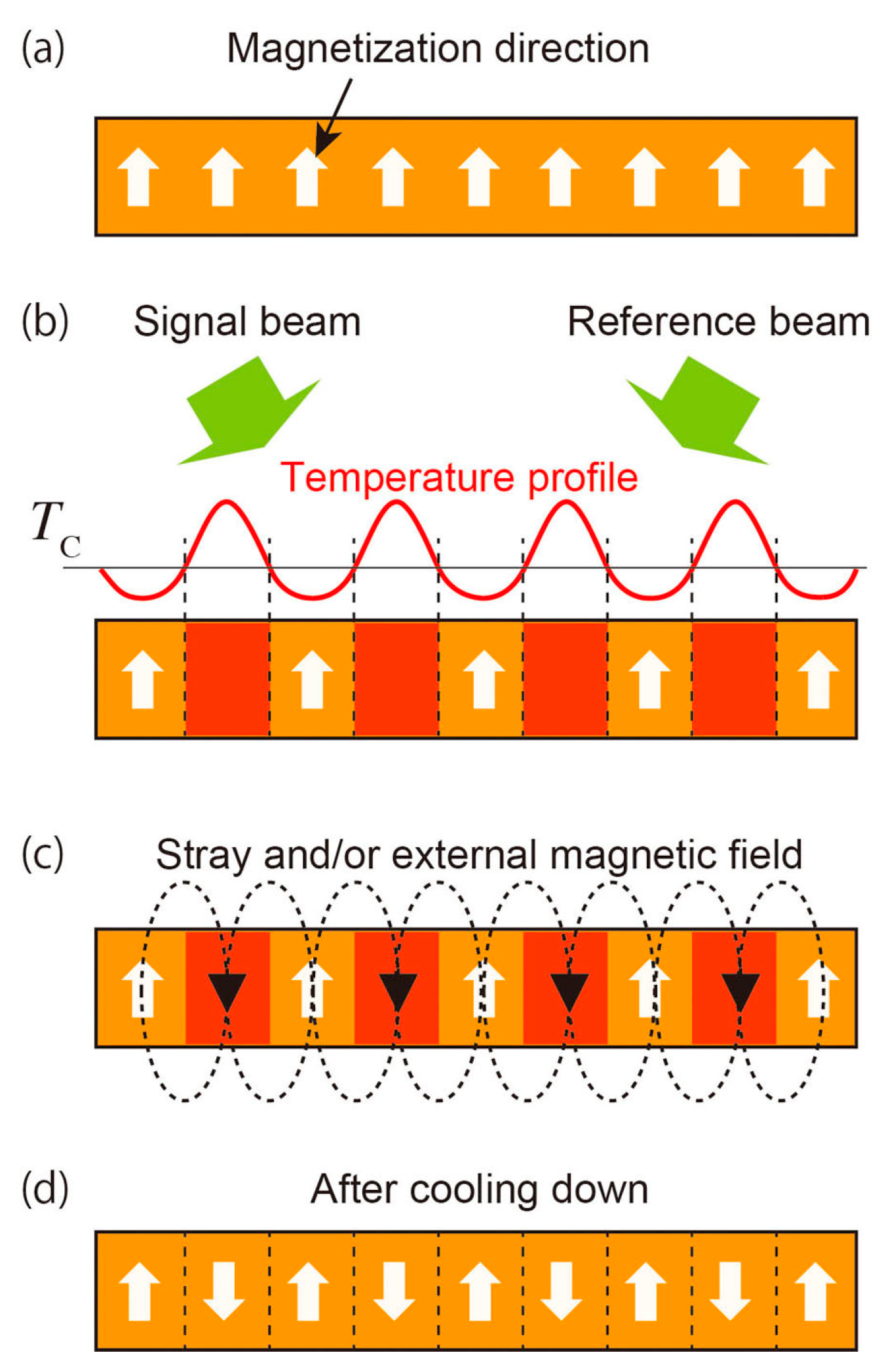

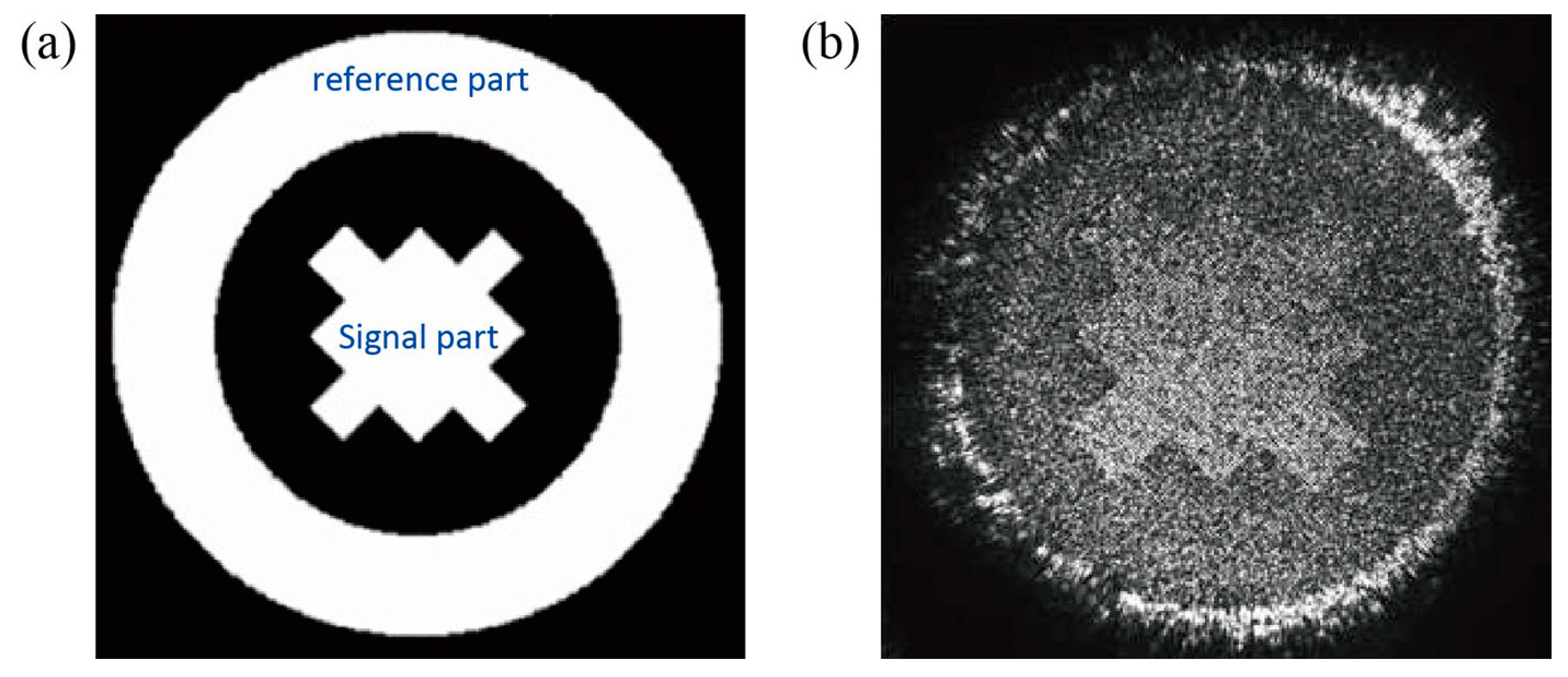

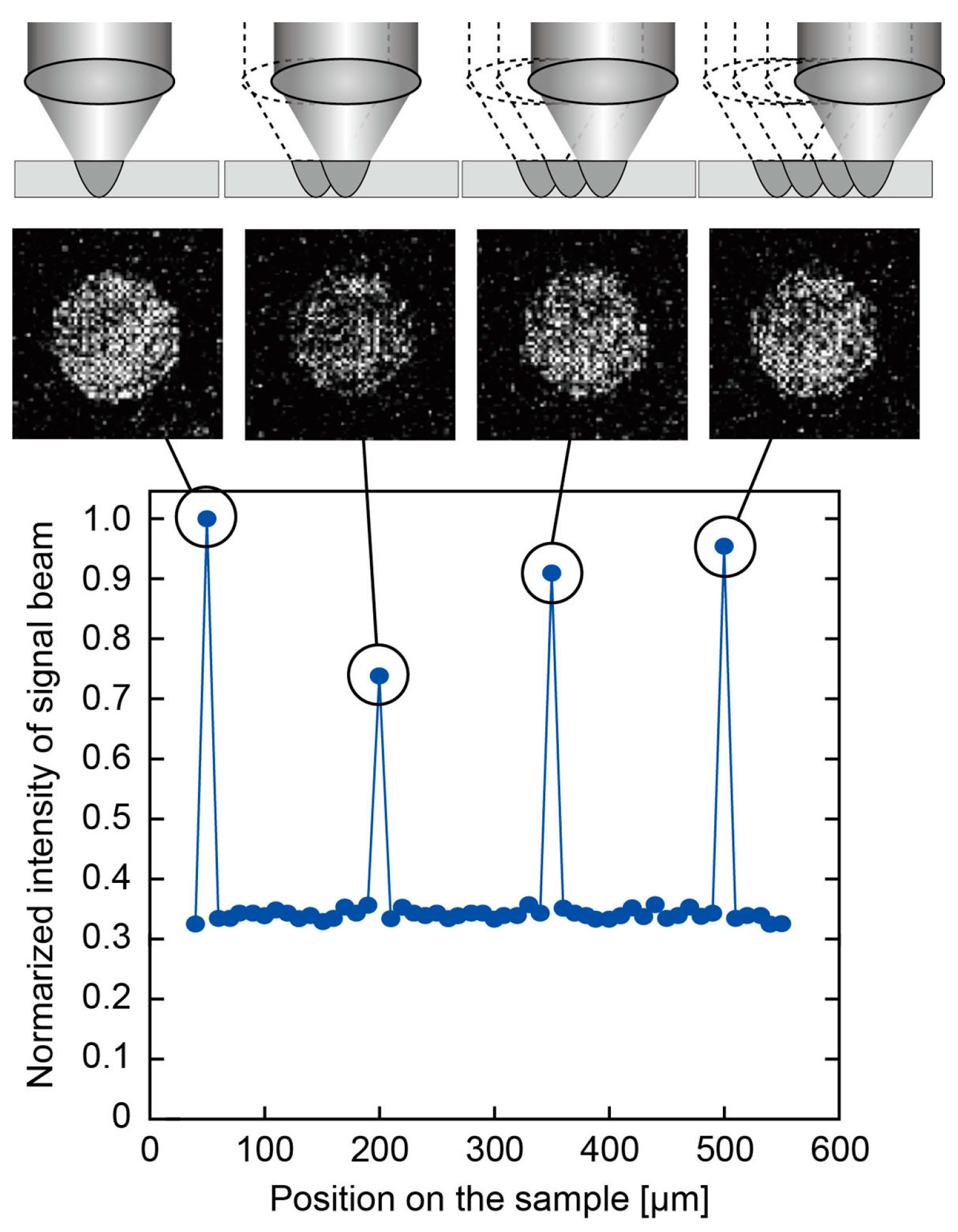
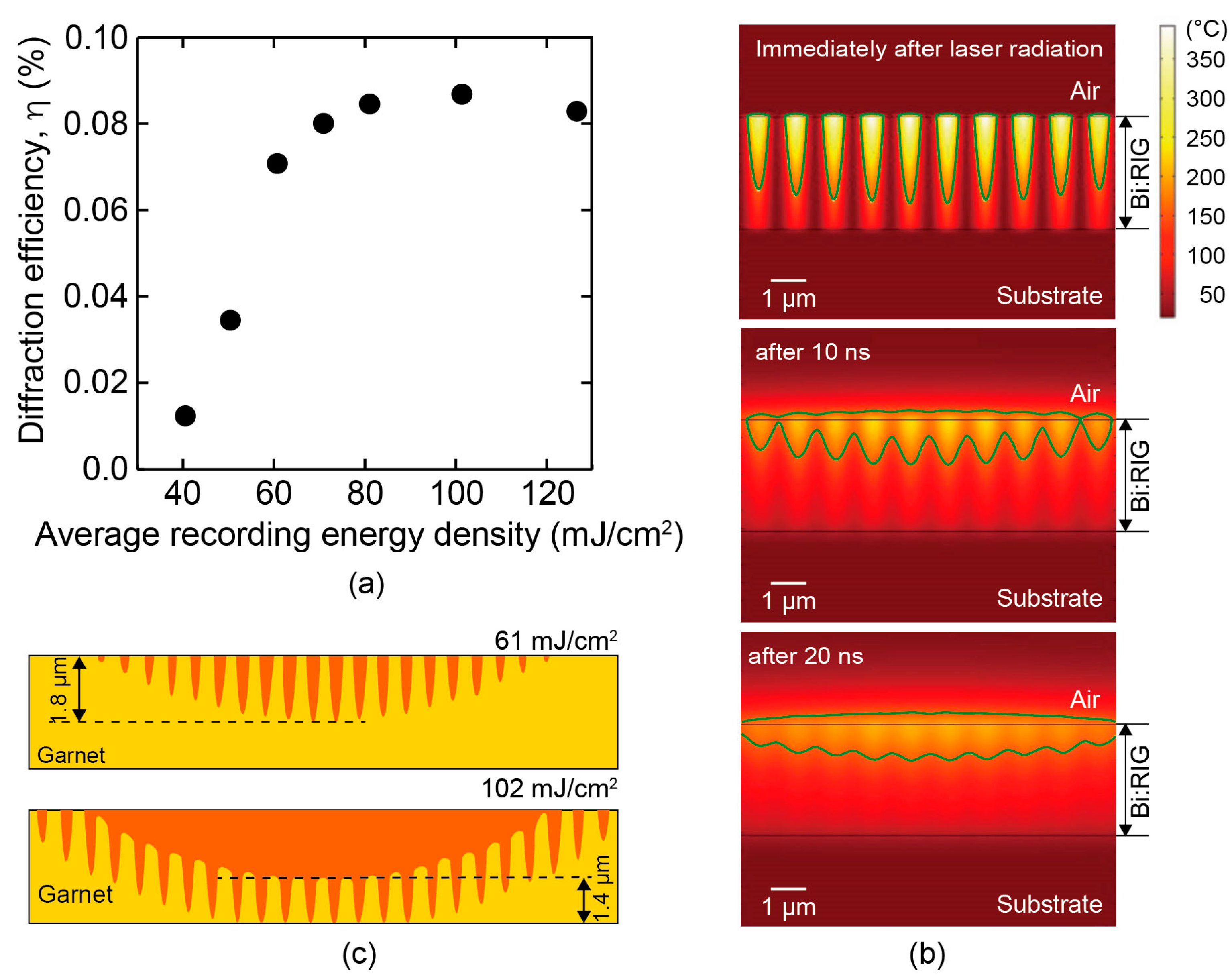

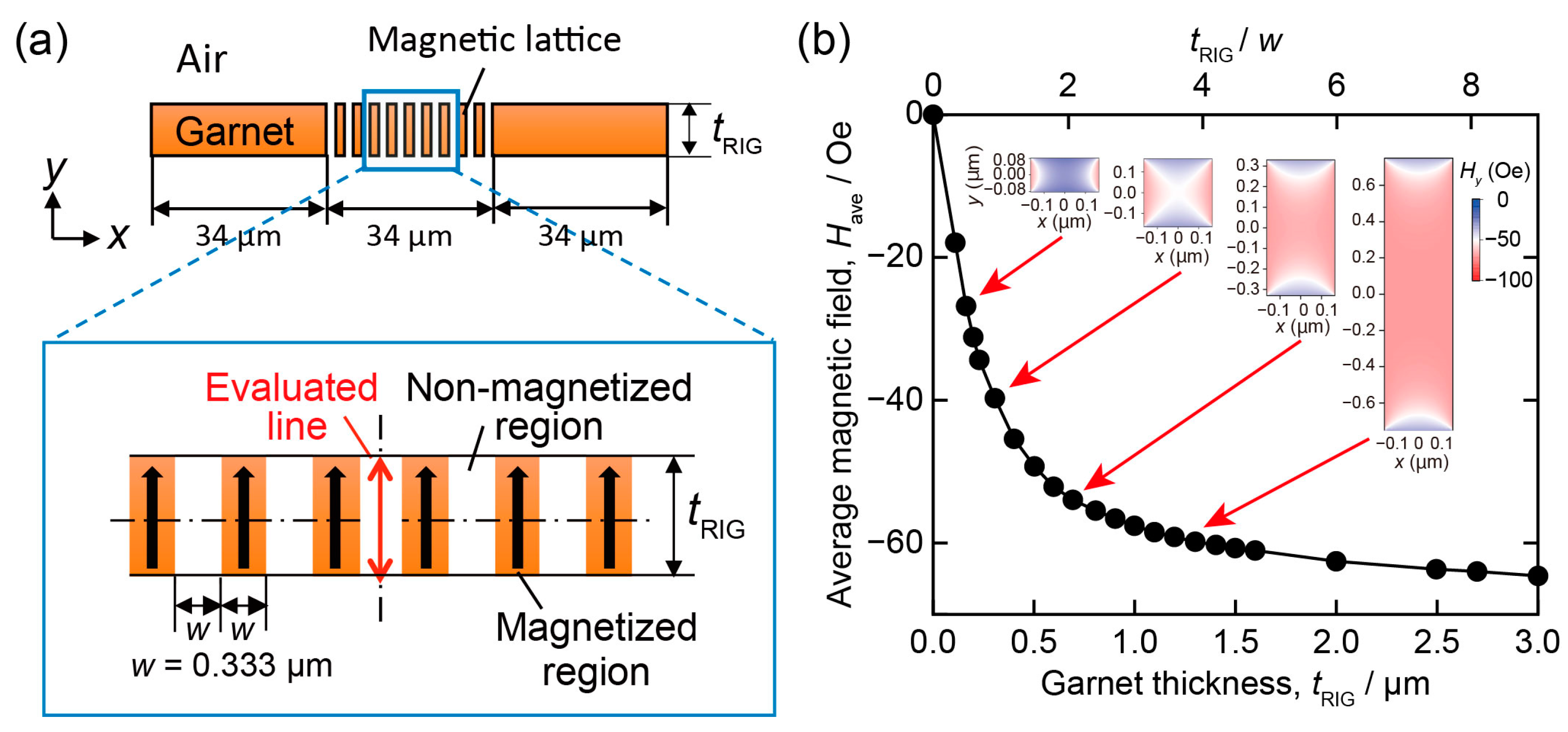
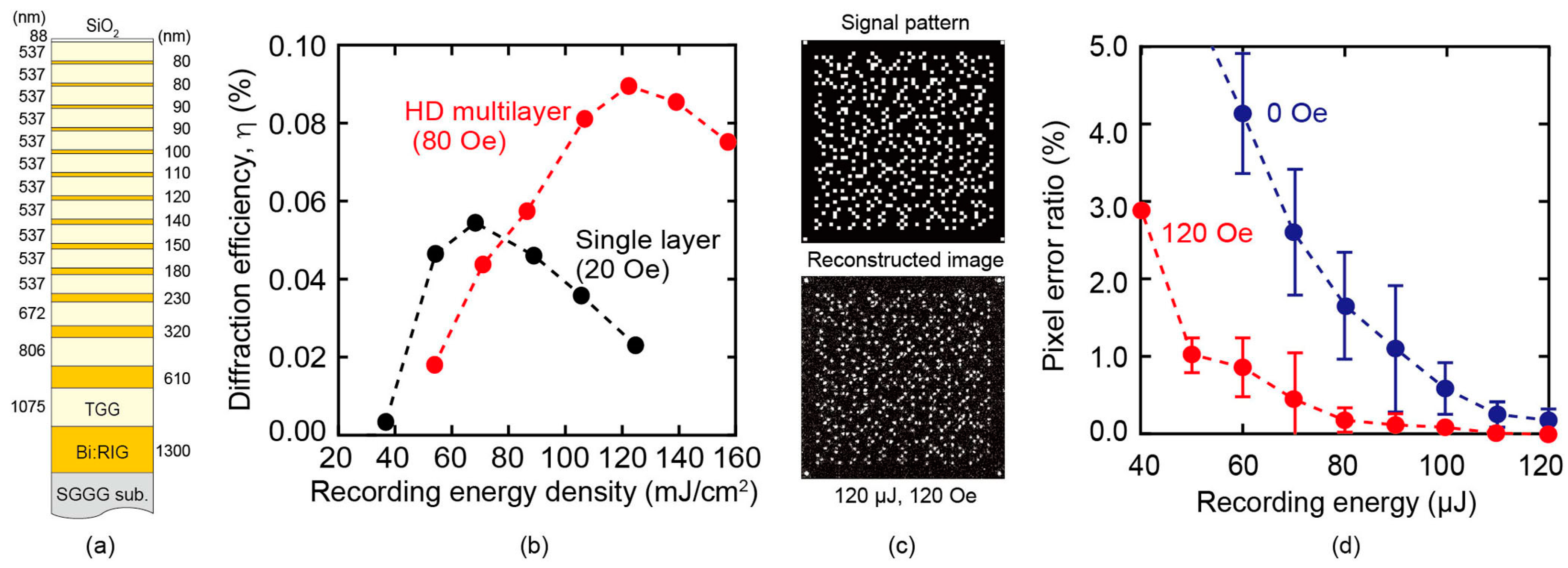
Publisher’s Note: MDPI stays neutral with regard to jurisdictional claims in published maps and institutional affiliations. |
© 2021 by the author. Licensee MDPI, Basel, Switzerland. This article is an open access article distributed under the terms and conditions of the Creative Commons Attribution (CC BY) license (https://creativecommons.org/licenses/by/4.0/).
Share and Cite
Nakamura, Y. Magnetic Holography and Its Application to Data Storage. Photonics 2021, 8, 187. https://doi.org/10.3390/photonics8060187
Nakamura Y. Magnetic Holography and Its Application to Data Storage. Photonics. 2021; 8(6):187. https://doi.org/10.3390/photonics8060187
Chicago/Turabian StyleNakamura, Yuichi. 2021. "Magnetic Holography and Its Application to Data Storage" Photonics 8, no. 6: 187. https://doi.org/10.3390/photonics8060187
APA StyleNakamura, Y. (2021). Magnetic Holography and Its Application to Data Storage. Photonics, 8(6), 187. https://doi.org/10.3390/photonics8060187



